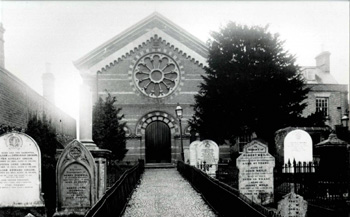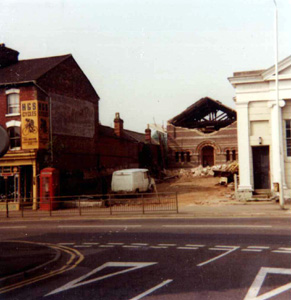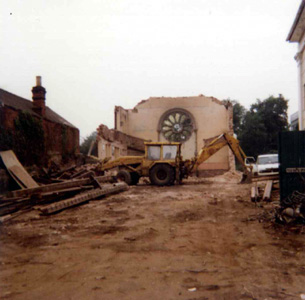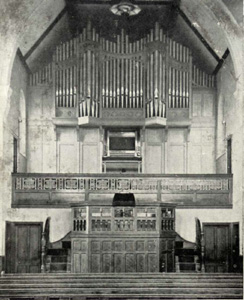Lake Street Baptist Church

Lake Street Baptist Church about 1910 [Z50/72/167]
Bedfordshire & Luton Archives & Records Service has a booklet written by H.G.Tibbutt in 1963 called the Baptists of Leighton Buzzard. It is, in some part taken from the history of the church written in the Free Communion Baptist Church Book [X648/3].
Lake Street Baptist meeting dated to 1775, the earlier Leighton Buzzard meeting being at an unknown location but may have been in Lake Street [see below]. The first pastor was Joseph James, a miller from Keysoe, which had a thriving Baptist meeting at Brook End. He was pastor for fourteen years until 1789 and kept a school to augment his stipend. His friend Robert Hawkins, not himself a Baptist, had purchased the old General Baptist meeting-house. After his death Hawkins' wife vested the meeting house and adjoining premises in the hands of six Baptist trustees. James died in 1791 after a long illness.
James was succeeded by Thomas Wake, pastor for thirty five years who arrived at a meeting with twenty one members and began by admitting seventeen new members. It was in his time that the old meeting, now too small, was replaced by a new building. Wake described the new meetings as: "about 32 feet by 34 feet: the pulpit opposite the door as you enter the meeting, the right and left hand galleries three seats deep and the front one dour ditto. It has been measured and will hold, when very closely seated, five hundred persons. Our constant congregation is more than four hundred and progressively approaching five hundred persons". At the time Wake stated he had been at Leighton Buzzard between eight and nine years, putting the new meeting's date at around 1801 or 1802. He went on: "When I first came the members were twenty one - our present number of members is more than one hundred. From Lady-day to Michaelmas I preach in the villages every Lord's day evening and during the winter six months reverse it to the mornings. During the moonlight part of the month throughout the year (haytime and harvest excepted) I preach on other evenings in most of the villages around me, for a distance of five, six or ten miles. One week in the month it so happens that I have to preach every evening in the week: at home on Monday - Burkit [Burcott, Buckinghamshire] on Tuesday - Heath on Wednesday - Selbury [Soulbury, Buckinghamshire] on Thursday - Wingrave [Buckinghamshire] on Friday: and catechise and deliver a lecture to my young hearers on Saturday afternoon; besides I have the constant business of my school every day". From the latter it looks as though he continued to teach at the school Joseph James had founded. He formed a Sunday School at the meeting in 1812.
On 2nd April 1799 the dwelling house of Zachary Whitehead, teacher was registered by Thomas Wake, Zachary Whitehead and John Craggs [RG31/2/101]. This may have been an emergency measure during the building of the new meeting. Perhaps Whitehead was a teacher at Wake's school. At the opening of the new meeting a number of people preached including "Mr.Greathead, a Pedo-baptist brother". The Lake Street meeting did not believe in infant baptism but other Baptist, called Pedo or Paedo-Baptists did. Clearly at this stage there was no animosity between the two groups. Holden's Directory of 1811 notes that John [sic] Wake was an anti-paedo-baptist minister in Leighton Buzzard. Wake became ill in 1827 and resigned his pastorship, dying the next year. He was buried in the cemetery adjoining the chapel, now under the modern buildings in Old Chapel Mews. His successor was Edward Adey.

Lake Street Baptist Church under demolition August 1983 [Z49/774]
Adey was an Independent (in more modern terms a Congregationalist) from Newport Pagnell [Buckinghamshire]; although a Baptist church Lake Street had Presbyterians and Independents in the congregation and practised open communion with sympathetic nonconformist churches. Early in Adey's pastorship forty seven members left to found a Baptist meeting in Great Brickhill [Buckinghamshire]. Also, a small group, unhappy with his pastorship and his conduct towards a female member of the congregation, also left and formed the Hockliffe Street meeting. To counterbalance those leaving, Adey brought in two hundred new members, meaning that in 1834 the meeting house had to be lengthened and a gallery installed to accommodate the Sunday School. The meeting in Lake Street was registered with the Archdeaconry of Bedford on 25th August 1837. Registration bought the benefit of exemption from parish poor rates, exemption from control by the Charity Commission and the right to be licensed to carry out marriages.
In 1850 membership of the meeting was officially opened to Independents and Presbyterians, who, as noted above, had been members of the congregation for some years. Infant baptism was still not permitted, however.
On Sunday 30th March 1851 a census of all churches, chapels and preaching-houses of every denomination was undertaken in England and Wales. The local results were published by Bedfordshire Historical Records Society in 1975 as Volume 54, edited by D.W.Bushby. The return for the Baptists in Lake Street was made by Edward Adey, who noted that the chapel could seat 569. Attendance had been 321, with 148 Sunday Scholars, in the morning, 149, with 170 Sunday Scholars, in the afternoon – grand totals of 469 and 319, with a mixed congregation of 243 in the evening. Adey further noted: “Sunday Scholars not required in evening. Upon Public occasions General Congregation much larger”. 19th century directories list the pastors of Lake Street as Particular Baptists which is somewhat confusing as most Particular or Strict Baptists did not practice the open communion practised at Lake Street. The attribution may be a mistake or it may be that Lake Street was particular in some respects and not in others.
Adey resigned as pastor in 1853, but remained as a deacon until 1855. The following year the chapel was renovated and at it reopening had Charles Haddon Spurgeon as guest preacher. Spurgeon is an important figure in the history of the Baptist Church. He was called "The Prince of Preachers" and had just married Susannah Thompson and later in the year was preaching at Surrey Gardens Music Hall when someone maliciously called out "Fire!" In the stampede that followed several people died and Spurgeon remained affected by the experience until his death in 1891. He was a committed anti-paedo-baptist and preached a famous sermon against infant baptism called "Baptismal Regeneration". In 1887 he initiated a controversy within the movement called The Downgrade Controversy. It was so-called because Spurgeon argued that Baptists had down-graded the role of The Bible in their beliefs and the debate continues in the Baptist movement today.
By 1864 the numbers worshipping at Lake Street had grown so great that a new building was needed and the foundation stone was laid on 17th March of that year. The new building opened on 8th September. The Sunday School was enlarged around 1900. On 11th October 1905 the church was re-opened after renovation, a new pulpit and baptistery.

Lake Street Baptist Church under demolition August 1983 [Z49/775]
During the First World War one of the congregation was killed in action. Joseph Bierton from 9 George Street, Leighton Buzzard, son of David and Leah and husband of Alice Elizabeth was killed on 17th February 1917, serving with the 4th Battalion, the Middlesex Regiment, he was a lance corporal and 32 years old. He is buried at Philosophe British Cemetery, Mazingarbe, near Béthune. He had a low number (F/3439) and belonged to a battalion which went to France in 1914 and so he may have been a serving soldier or a reservist at the outbreak of war.
In 1961 John Forrest Neilson became pastor of both Lake Street and Hockliffe Street Baptist church. Records at Bedfordshire & Luton Archives & Records Service do not state when the Lake Street meeting closed; it was demolished in August 1983 and private accommodation in Old Chapel Mews now stands on the site of both the meeting house and the burial ground.

Old Chapel Mews October 2008
Sources
- X648/1: Register of births and burials: 1771-1835;
- X648/2a: Parchment cover to X648/1 with list of names: C18-C19;
- X648/2b: Loose certificates of baptism, marriage and burial found inside X648/1: 1789-1842;
- X648/3: Free Communion Baptist Church Book with various lists of members, church history and minutes of church meetings: 1829-1913;
- BO1408: Claim by proprietors to estate in Leighton Buzzard: 1843;
- X648/4: Church minute book: 1914-1928;
- X648/7: Band of Hope account book: 1916-1926;
- X648/9: Church Treasurer's account book: 1919-1936;
- Z676/2/1: Marriage register: 1920-1962;
- X648/5: Deacons' meetings minute book: 1925-1936;
- X648/6: Sunday School minute book: 1932-1939;
- X648/10: Details of minister, church membership, buildings, minister's income, weekday meetings etc.: 1935;
- The Baptists of Leighton Buzzard by H.G.Tibbutt: 1963

Lake Street Baptist church organ about 1920 [Z1130/72]
List of Pastors to 1963
- Joseph James: 1775-1789;
- Thomas Wake: 1793-1828;
- Edward Adey: 1829-1853;
- Samuel Cowdy: 1853-1861;
- William Delf Elliston: 1861-1893;
- Frank Edward Robinson: 1894-1896;
- Alfred James Grant: 1897-1902;
- John William Mayo: 1903-1910;
- J.A.Arnold: 1910-1911;
- Richard Thomas Anderson: 1912-1918;
- Alexander William Pay: 1918-1924;
- Charles Edwin Sparrow: 1925-1927;
- Ernest William Labrum: 1928-1933;
- Richard Thomas Anderson: 1934-1936;
- Thomas Arthur Williams: 1937-1943;
- Alfred Ernest Edwards: 1953-1956;
- John Forrest Neilson: 1961-1963